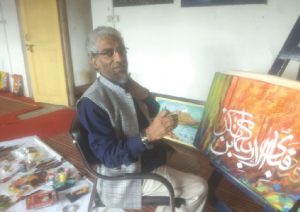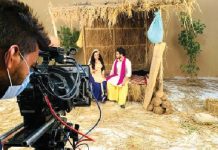 Inside an old nondescript building at Srinagar’s Barazulla locality, the soft October sun sieves through the windows and lights up the profile of a man in earnest contemplation seated in a chair. The sun reveals a haggard oval face covered with a scrawny white beard.
Inside an old nondescript building at Srinagar’s Barazulla locality, the soft October sun sieves through the windows and lights up the profile of a man in earnest contemplation seated in a chair. The sun reveals a haggard oval face covered with a scrawny white beard.
His hair is neatly combed back to reveal a prominent forehead, and round rimmed spectacles over gentle eyes complete the impression of an elderly gentleman. Dressed in a neat checked tweed waistcoat over a blue sweater, and khaki pants he looks like any elderly Kashmiri gentleman. Yet, 52-year-old Mir Mushtaq — the gentleman in question is anything but ordinary.
On entering, the first thing one notices is Mushtaq dabbling with colour in his art studio, SM Mushtaq Art Gallery. He specializes in handmade paintings, Islamic calligraphy and modern art. Many specimens of his expertise are piled against the canvas stands or hung on the walls.
A classic pastoral shows a deer in a bower gazing serenely, while the forest paths meanders before her. Another is a panoramic portrayal of the old city as visible from Zaina Kadal Bridge — one of the six bridges that lend the city its old world charm. Flourishing his brush with bold strokes with an ease of expertise, the canvas comes alive with a calligraphic reproduction of a verse from Quran: Fabi-aiyi-alai kuma tukkaziban (Which of the favours of your Lord will you deny?)
Mushtaq certainly is not one to deny. Battling stage 4 throat cancer, pain and trauma for the last one year, he hasn’t let his illness come in the way of art. Rather, he credits his brush and colours for giving him confidence and hope, when he had almost succumbed to disease. Always a talkative, jovial man, he found his voice strangled when his vocal chords were surgically removed to stall the cancer. Now, he talks almost in a hoarse whisper interrupted by bouts of a wheezing cough. He found his voice back in colour and canvas.
“My only mantra is that life might be transient but art lives forever,” he reflects with a warm smile.
Hailing from Srinagar’s Lal Chowk area, Mushtaq’s love for art took root in his childhood. His father’s tailoring shop at Court Road, the city center was the first muse.
“As a kid, I accompanied my father on weekends. At the shop, I noticed the fleeting sights and bustling life on the streets. This would remain in my mind and I soon drew them out,” he said.
In 1977, he joined the‘Institute of Music and Fine Arts’then situated in Srinagar’s uptown area Jawahar Nagar for a three-year degree in Art. “I learnt clay modelling, sculptor making, designs in wood carving there. My first and second year in college gave me so many insights into the world of art. But as soon as I entered my third year, my whole world turned upside down.”
His father passed away in the third year of his college, and financial constraints meant Mushtaq had to drop out to earn for the family. The bitter struggle that followed took him to Mumbai in 1981 where a chance encounter with Syed Siddiqi — a Hyderabad based artist, left him transformed.
“It was by accident that I happened to interact with Syed Sahab while travelling. And soon he learnt, I too was a fellow traveler on a quest. It was his love for the art and artists that he took me under his wing and taught the nuances of micro art and other techniques of painting,” he says.
In 1983, Mushtaq returned to Kashmir and set up a business of advertising and screen printings in old city’s Gawkadal.
“Screen printing was a costly affair those days. There were no computers, and the processing of designs was a tedious process. I myself painted out several intricate designs of visiting and wedding cards and they received a good response from the clients,” he narrates.
The business continued to bloom till the turbulence of 90’s when militancy reared its head. Gawakdal was the literal eye in the storm, as the massacre at Gawakadal Bridge fanned the fires yet to be extinguished. Everything collapsed around him, and Mushtaq was left in dire straits again.
“90 came as jolt out of the blue. The situation around me deteriorated rapidly with each passing day, before I even had a chance to react. I had invested around 14-15 lakhs in my business. It was a fairly big amount in those days compared to today. I lost it all,” he recounts.
Mushtaq had to sell all his property including his spacious home and office place. Having lost everything, he again sought refuge in art.
“It was a very difficult time and there was a killing and bloodshed almost every day. “Ye kaun mara, Ye kiska lahu hai, akhir kab tak, (Who died, whose blood is this, when will it end?), a verse by Sahir Ludhianvi which was the catchphrase of the 90’s, and ‘Curfewed nights’” were some of themes of my paintings from those times,” he says.
With a never-die-spirit of a true artist, Mushtaq managed to revive his business again in a couple of years. By 2014 he had managed to create a large portfolio, and planning to exhibit his paintings on a large scale for the first time. But fate had another twist in store. Unprecedented floods hit the valley on September 7, and in it went floating away all his art works. He was left bereft just like before. “Majority of my artworks were swept by floods. I wept tears of blood that day.”
Loss and hope are a motif of Mushtaq’s life. No sooner does he pick up the pieces than another tragedy hits him. He had barely recovered from the floods, when he was diagnosed with cancer of the throat, and given barely a few months to live. But, he continues to paint and strive. The connoisseur of fine art and music he is he ends with a line by Faiz:
“I still haven’t lost hope. Ye haath salamat hai kab tak, is khoon main hasrat hai jab tak (Till these hands are able to labour/ till warm blood gushes through my veins), I will continue to paint,” he concludes.
letters@tehelka.com













